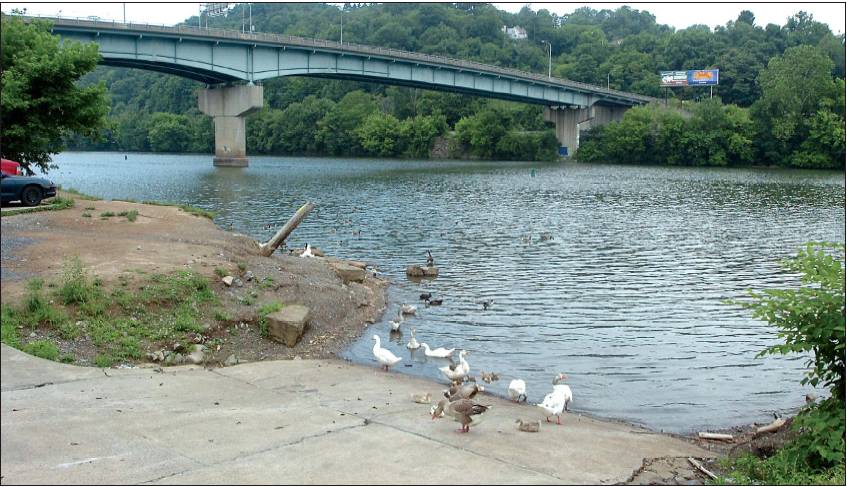
Morgantown Dominion Post
29 June 2007
By Cassie Shaner

The water enter to the swim area of the MedExpress Mountaineer Triathlon is located at the boat ramp in Hazel Ruby McQuain Park - Jason DeProspero/Dominion Post
The Dominion Post tested the stretch of the Monongahela River where swimmers will participate in Sunday's MedExpress Mountaineer Triathlon.
The water was tested at the point where athletes will enter the water, midway through the course, and at the point where participants will leave the water to continue the contest aboard bicycles.
Results from some tests seemed somewhat high, said Craig Mains, an engineering scientist at WVU's National Environmental Services Center. Mains said the water wouldn't necessarily make someone sick, but he would be reluctant to swim in it.
"I probably would, but I'm cautious by nature," he said.
Triathlon participants will swim, run and bicycle in the Sunday Olympic distance race, which features a swim of 1,500 meters - or a little less than one mile. Swimmers entered in the half-ironman distance race will travel 1.2 miles along the Monongahela River.

With about 700 swimmers expected to take the plunge, The Dominion Post hired Sturm Environmental Services in Bridgeport to test water samples for bacteria levels. Sturm took samples about 20 feet from the river shoreline in three locations along the swimmers' course June 19 and June 25.
Mains was particularly concerned about an E. coli reading of 1600 MPN, meaning the most probable number of E. coli bacteria found in 100 milliliters of water. "That seems like a pretty high number to me," Mains said.
Most strains of E. coli are harmless. However, some E. coli bacteria found in the intestines of humans and animals produce a powerful toxin and can cause severe illness. Mains said it was hard to evaluate the findings without knowing the origins of the coliforms, or bacteria.
The test results were as follows:
June 19 - total coliform upstream (the exit point), midstream and downstream (the entry point), all greater than 1,600 MPN. E. coli upstream, 1,600, midstream, 4, downstream 240. Previous tests done by The Dominion Post indicated the other numbers indicate insignificant amounts of material.
June 25 - total coliform upstream, 500, midstream greater than 1,600, downstream, 900. E. coli upstream, 80, midstream 30, downstream 23. Again, scientists evaluating previous tests were not concerned with the numbers under 1,600.
Sturm would not comment on these tests, saying they are not statisically valid. Typically, more tests are done over a longer span of time to get a better measure of possible pollutants.
Jay Redmond, Greater Morgantown Convention and Visitors Bureau sports and special events director, said he disagreed with Mains' evaluation.
"The water is tested regularly, and it's never been deemed to be hazardous...," he said. "There is no hazard to this event going on in the river, none whatsoever."
Redmond speculated a lack of rain may have affected the test results. Mains said that recent rainfall, a prolonged lack of rain, or ducks and other animals along the river may have affected the results.
Abby Meadema Steketee is suing the Greater Morgantown Convention and Visitors Bureau, and Health and Fitness Promotions, an Ohio company that organizes triathlons, for an injury she suffered in the 2005 Mountaineer Triathlon. She claims they acted negligently when she cut her foot on a sharp object while entering the Monongahela River for the swimming portion of the race. The wound became severely infected and required surgery, the lawsuit said.
Meadema Steketee alleges the Monongahela River was contaminated at the time and said the event sponsors provided no first-aid. The Greater Morgantown Convention and Visitors Bureau contends it is not liable for the injury.
Though Mains was slightly concerned, he said it's up to triathlon contestants to decide whether or not to take the plunge. "There's a certain amount of risk, and [swimmers] probably have to evaluate that risk themselves," Mains said.